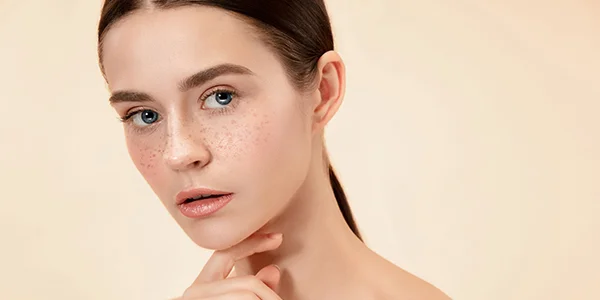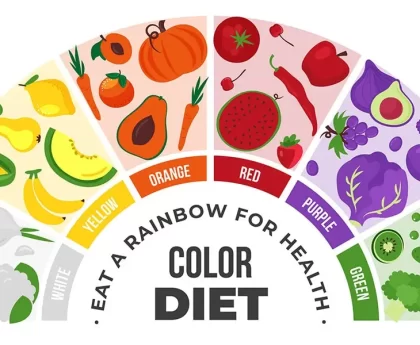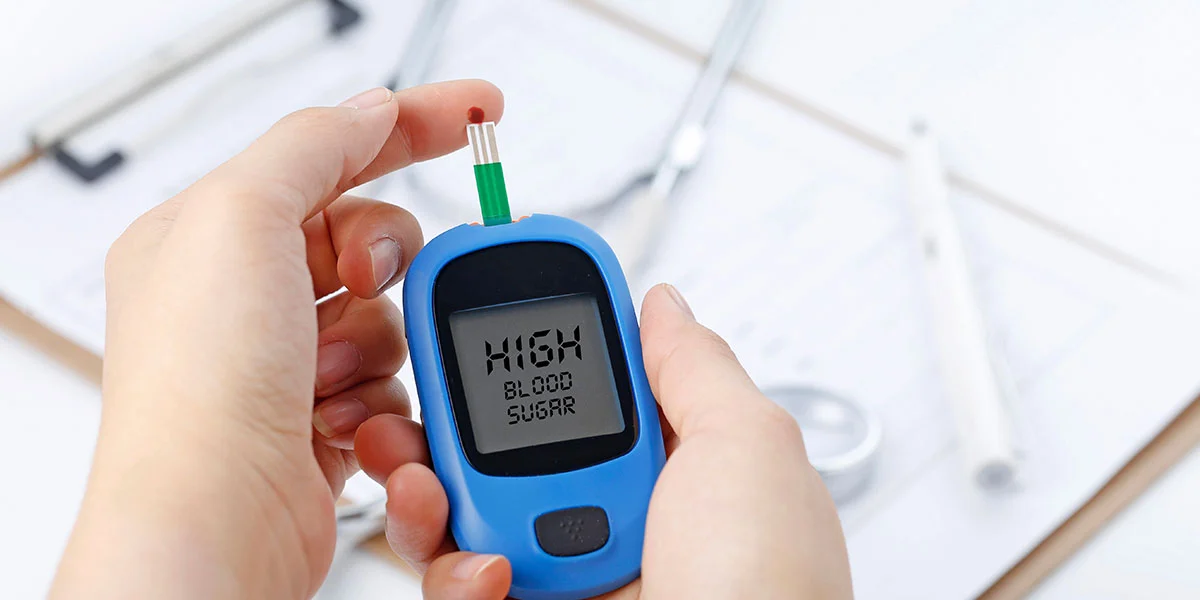Freckle: also known as an ephelis, is a small, flat, pigmented spot on the skin. Freckles are typically tan, light brown, or reddish-brown in color and are usually round or oval in shape. They are caused by an uneven distribution of melanin, the pigment responsible for skin, hair, and eye color, in the skin.
Freckles are often more noticeable in individuals with fair or light skin and are often triggered or accentuated by sun exposure. They can appear on various parts of the body, including the face, arms, shoulders, and chest. Freckles are not associated with any medical condition and are generally harmless. However, they can change in appearance or become more numerous over time, and any unusual changes should be examined by a healthcare professional to rule out any potential skin issues.
Types of Freckle
Freckles primarily come in two main types: ephelides and lentigines.
These two types of freckles differ in their causes and characteristics:
- Ephelides:
– Ephelides are the most common type of freckles.
– They are usually light to medium brown in color and are more prominent in individuals with fair or light skin.
– Ephelides are primarily caused by exposure to ultraviolet (UV) radiation from the sun. When the skin is exposed to sunlight, melanocytes (cells that produce melanin) increase melanin production in an attempt to protect the skin from UV damage. This leads to the formation of ephelides.
– Ephelides tend to fade or become less noticeable during the winter months when there is less sun exposure but often darken or become more numerous with increased sun exposure. - Lentigines:
– Lentigines, also known as solar lentigines or liver spots, are a type of freckle that is more common in older individuals, typically over the age of 40.
– They are usually darker in color, ranging from light brown to dark brown or even black.
– Unlike ephelides, lentigines are not solely caused by sun exposure. They can develop in areas of the skin that have experienced cumulative sun exposure over many years. They are also associated with aging and genetic factors.
– Lentigines are often larger and more defined than ephelides and may appear as flat, slightly raised, or slightly scaly spots on the skin.
– They are more likely to persist throughout the year and do not necessarily lighten during the winter months.
It’s important to note that while ephelides are generally considered harmless and are a normal skin variation, lentigines, especially if they change in size, shape, color, or become irregular, should be evaluated by a dermatologist, as they can sometimes be an early sign of skin cancer or other skin conditions. Regular skin checks and sun protection are essential for maintaining skin health and preventing skin damage from UV radiation.
Symptoms of Freckle
Freckles themselves are not associated with specific symptoms, as they are benign skin pigmentation variations caused by the uneven distribution of melanin in the skin. However,
There are some characteristics and considerations related to freckles that individuals may want to be aware of:
- Appearance: Freckles typically appear as small, flat, pigmented spots on the skin. They are usually tan, light brown, or reddish-brown in color and may vary in size and shape. Freckles are often more noticeable in individuals with fair or light skin.
- Sun Sensitivity: Freckles can become more prominent or darken with sun exposure. This is particularly true for ephelides, the freckles caused by UV radiation from the sun. Sun sensitivity can lead to the temporary darkening of freckles during the sunny months.
- Changes Over Time: Freckles themselves do not typically change in appearance or cause discomfort. However, if a freckle undergoes any of the following changes, it may warrant medical attention:
– Changes in size, shape, or color
– Irregular or uneven borders
– Bleeding, itching, or crusting
– Ulceration or scabbing
– Rapid growth or multiplication of freckles
Any of these changes could be a sign of a more serious skin condition, such as melanoma (a type of skin cancer), and should be evaluated by a dermatologist promptly.
- Multiple Freckles: Some individuals may have a few freckles, while others may have numerous freckles across their skin. The number and distribution of freckles can vary from person to person and are influenced by genetics, sun exposure, and skin type.
- Location: Freckles can appear on various parts of the body, with common areas including the face, arms, shoulders, and chest. They may also occur on other sun-exposed areas of the skin.
It’s important to note that freckles themselves are generally harmless and do not require treatment. However, it is crucial to practice sun protection, including the use of sunscreen and protective clothing, to prevent further sun-induced skin damage and reduce the risk of skin cancer, especially in individuals with a tendency to develop freckles. If you have concerns about any changes in your skin, consult a healthcare professional or dermatologist for a thorough evaluation.
Causes of Freckle
Freckles are primarily caused by the uneven distribution of melanin in the skin. Melanin is the pigment responsible for the color of our skin, hair, and eyes.
The main causes of freckles are as follows:
- Genetics: The tendency to develop freckles is often inherited. If your parents or grandparents have freckles, you are more likely to develop them as well. Specific genes are associated with freckle formation.
- Sun Exposure: Sun exposure is a major factor in the development of freckles. When the skin is exposed to ultraviolet (UV) radiation from the sun, it triggers the production of melanin as a natural defense mechanism to protect the skin from UV damage. However, in individuals prone to freckling, the melanin is not evenly distributed, leading to the formation of freckles.
- Skin Type: Freckles are more common in individuals with fair or light skin, as they have less melanin overall. People with darker skin have more melanin and are less prone to freckles.
- Hormones: Hormonal changes can influence the development of freckles. For example, some individuals may notice an increase in freckles during pregnancy, a condition known as “pregnancy mask” or melasma. Hormonal changes can affect melanin production and distribution.
- Age: Freckles often become more pronounced with age, particularly if there is ongoing sun exposure. Older individuals may develop lentigines, also known as age spots or liver spots, which are a type of freckle associated with aging and cumulative sun exposure.
It’s essential to note that freckles themselves are generally harmless and are considered a normal variation of skin pigmentation. However, because they are associated with sun exposure, it’s crucial to take precautions to protect your skin from the sun’s harmful UV rays to prevent further freckling and reduce the risk of skin damage and skin cancer. This includes wearing sunscreen, protective clothing, and seeking shade when necessary, especially if you are prone to freckles.

Prevention of Freckle
Freckles are often influenced by genetic factors and sun exposure, but you can take steps to help prevent freckles and minimize their development.
Here are some preventive measures:
- Sunscreen: The most effective way to prevent freckles and protect your skin from sun damage is to use sunscreen regularly. Choose a broad-spectrum sunscreen with a high SPF (sun protection factor) of 30 or higher. Apply it generously to all exposed skin, even on cloudy days. Reapply every two hours or more frequently if swimming or sweating.
- Protective Clothing: Wear protective clothing, such as long-sleeved shirts, wide-brimmed hats, and sunglasses, when you’re exposed to the sun. This helps reduce direct UV exposure to your skin.
- Seek Shade: Whenever possible, seek shade, especially during the peak hours of sunlight, which are typically between 10 a.m. and 4 p.m. This can significantly reduce your UV exposure.
- Avoid Tanning: Avoid tanning beds and sunbathing, as these activities can increase your risk of freckles and other skin damage. Opt for self-tanning products or spray tans if you want a tan appearance.
- Limit Sun Exposure: Be mindful of your sun exposure, especially if you are prone to freckles. Try to minimize the time you spend in direct sunlight, and take breaks in the shade when you’re outdoors.
- Use Sun-Protective Products: Consider using clothing and accessories specifically designed for sun protection, such as sun-protective swimwear and UV-blocking umbrellas.
- Hats and Sunglasses: Wear a wide-brimmed hat to protect your face and neck, and don’t forget to wear UV-protective sunglasses to shield your eyes and the delicate skin around them.
- Hormonal Changes: If you notice that your freckles are becoming more pronounced due to hormonal changes, such as during pregnancy, consult with a healthcare professional for guidance on managing these changes.
- Regular Skin Checks: Keep an eye on your skin and any changes in freckles or other moles. If you notice any unusual changes, such as new, changing, or irregularly shaped freckles, consult a dermatologist for a skin examination.
Remember that while these measures can help prevent freckles, they are also essential for protecting your skin from sunburn and reducing the risk of skin damage and skin cancer. Freckles themselves are generally harmless, but protecting your skin from the sun’s harmful UV rays is essential for overall skin health.
Why is Freckle important?
Freckles themselves are not inherently important in a medical or biological sense. They are a benign and harmless variation of skin pigmentation caused by the uneven distribution of melanin in the skin. In other words, freckles are a natural occurrence and are not associated with any essential bodily functions or health-related significance.
However, freckles can be of interest or importance to individuals for several reasons:
- Aesthetic Considerations: Some people find freckles aesthetically pleasing and consider them a unique and attractive feature of their appearance. Freckles can contribute to an individual’s distinctive look and character.
- Cultural and Social Significance: Freckles are sometimes associated with cultural or regional beauty standards. In some cultures, freckles are highly valued, while in others, they may be less emphasized.
- Personal Identity: For individuals with freckles, they can be a part of their personal identity and may even be a source of pride.
- Sun Awareness: Freckles can serve as a visual reminder of the importance of sun protection. People with freckles often realize that their skin is more sensitive to the sun and may take extra precautions to avoid sunburn and reduce the risk of skin damage and skin cancer.
- Skin Health: Changes in freckles or the development of new or irregular freckles can sometimes be an indicator of underlying skin issues, such as skin cancer. Monitoring changes in freckles can be part of a broader approach to maintaining skin health.
In summary, while freckles themselves are not inherently important from a medical perspective, they can hold personal, cultural, and social significance. Additionally, they can serve as a reminder of the importance of sun protection and skin health. If you have concerns about your freckles or notice any changes in them, it’s a good idea to consult a healthcare professional or dermatologist for guidance and evaluation.
Can freckles show through makeup?
Yes, freckles can show through makeup, especially if the makeup products you use have light to medium coverage. Makeup is designed to even out skin tone and cover imperfections, but it may not completely conceal freckles, as freckles are typically darker pigmented spots on the skin.
Here are some factors to consider regarding freckles and makeup:
- Coverage Level: The coverage level of your makeup products plays a significant role in how well freckles are concealed. Products with light coverage, such as tinted moisturizers or sheer foundations, may allow freckles to show through more prominently. On the other hand, full-coverage foundations and concealers can provide more effective coverage.
- Application Technique: How you apply makeup can also affect how well freckles are concealed. Using a makeup brush, sponge, or beauty blender to blend foundation evenly can help provide better coverage than using your fingers.
- Color-Correcting: Some individuals choose to embrace their freckles and opt for makeup that enhances rather than conceals them. In such cases, makeup artists might use color-correcting techniques to ensure freckles stand out or blend seamlessly with the overall look.
- Setting Powder: Setting your makeup with a translucent setting powder can help improve coverage and reduce shine, but it may also make freckles less visible.
- Natural Finish: If you want to maintain a natural look and let your freckles show through, you can use makeup products with a dewy or natural finish, which can be less heavy in coverage.
Ultimately, whether you choose to conceal or embrace your freckles with makeup is a personal preference. Some people love the natural look of their freckles and choose makeup products and techniques that allow them to show through. Others prefer full coverage to achieve a flawless complexion. It’s essential to choose makeup products and techniques that align with your desired look and comfort level.
Iodine Deficiency: Symptoms, Causes, & Home Remedies
Insomnia: Types, Symptoms, Causes & Prevention
Sore Throat, Symptoms, Causes, Prevention & Home Remedies
Dandruff: Types, Symptoms, Causes & Prevention
Dark Circles Under Eyes: Symptoms, Remedies & Prevention
Heart Attack: Types, Symptoms & Prevention
Eye Infections: Symptoms, Causes & Treatment
Vertigo: Causes, Symptoms, Treatment & Preventive
Hair Loss, Types, Symptoms, Prevention & Treatments
Knee Pain, Symptoms, Types & Self Management
If you don’t like this article/post please share your feedback





